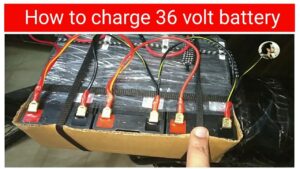If you’ve ever found yourself standing in front of a battery display, unsure of which one to choose, you’re not alone. With so many different types of batteries available, it can be challenging to navigate the options and find the right one for your needs. But fear not! When it comes to identifying AGM batteries, we’ve got you covered. In this article, we’ll walk you through everything you need to know about how to identify AGM batteries, so you can make an informed decision and power up with confidence. So, let’s dive in and unravel the mystery of AGM batteries together!
How to Identify an AGM Battery
An Absorbent Glass Mat (AGM) battery is a type of lead-acid battery that provides a reliable power source for various applications, from vehicles to renewable energy systems. AGM batteries have become increasingly popular due to their superior performance and maintenance-free operation. However, identifying an AGM battery can sometimes be a challenge, especially for those unfamiliar with this battery technology. In this article, we will discuss the key characteristics and methods to identify an AGM battery effectively.
Understanding AGM Battery Technology
Before diving into the identification process, let’s take a moment to understand the basics of AGM battery technology. AGM batteries are constructed differently from traditional flooded lead-acid batteries. In an AGM battery, the electrolyte is absorbed within a fiberglass mat, which increases efficiency and enhances the battery’s performance. This design ensures that the battery remains leak-proof, maintenance-free, and resistant to vibration, making it an excellent choice for various applications.
Physical Characteristics of AGM Batteries
One of the easiest ways to identify an AGM battery is by examining its physical characteristics. Here are some key features to look for:
- Appearance: AGM batteries typically have a rectangular or square shape.
- Color: AGM batteries often have a gray or black casing, distinguishing them from other battery types.
- Labeling: AGM batteries are usually clearly labeled as “AGM” or “Absorbent Glass Mat.”
- Valve: AGM batteries often have a valve on top, indicating a sealed design.
- Weight: AGM batteries tend to be heavier than other battery types due to their construction.
Taking note of these physical characteristics can help you quickly identify if a battery is an AGM battery.
Reading the Battery Label
The battery label provides essential information about its type and specifications. When trying to identify an AGM battery, pay attention to the following details on the battery label:
- Battery Type: Look for labels indicating “AGM,” “Absorbent Glass Mat,” or “Sealed Lead Acid.”
- Voltage: AGM batteries usually have a voltage rating of 12V, but higher voltage options are available.
- Capacity: The battery label displays the capacity, typically measured in ampere-hours (Ah), indicating the amount of charge the battery can hold.
- CCA Rating: Cold Cranking Amps (CCA) represents the battery’s ability to start an engine in cold temperatures. AGM batteries often have higher CCA ratings compared to other battery types.
- Manufacturer: Take note of the manufacturer’s name and make sure it is reputable to ensure the quality and reliability of the AGM battery.
By carefully reading the battery label, you can gather valuable information that aids in identifying an AGM battery accurately.
Using the Battery Model Number
AGM batteries often have a unique model number or part number, which can be another useful tool in identifying them. The model number typically includes specific codes or abbreviations that indicate the battery’s type. Look for keywords such as “AGM,” “SLA” (Sealed Lead Acid), or “VRLA” (Valve Regulated Lead Acid) in the model number. These indicators confirm that the battery is an AGM type.
Seeking Manufacturer Documentation
If you still have doubts about whether a battery is an AGM battery, you can reach out to the manufacturer for clarification. Manufacturers often provide detailed documentation and customer support. Contacting the manufacturer directly can ensure accurate identification and help you make an informed decision regarding your battery needs.
Consulting with a Battery Expert
When in doubt, consulting with a knowledgeable battery expert or a professional in the industry is another reliable way to identify an AGM battery. Battery experts have the experience and expertise to distinguish between different battery types quickly. They can also provide guidance on selecting the right AGM battery for your specific application.
Identifying an AGM battery is crucial for selecting the right power source for your needs. By examining the physical characteristics, reading the battery label, and utilizing the model number, you can confidently identify an AGM battery. Don’t hesitate to seek assistance from the manufacturer or a battery expert if you need further clarification. With this knowledge, you are equipped to choose the optimal AGM battery for your specific application and ensure reliable and efficient power.
Frequently Asked Questions
How can I identify an AGM battery?
An AGM (Absorbent Glass Mat) battery can be identified by its appearance and labeling. Here are some ways to identify an AGM battery:
What does an AGM battery look like?
An AGM battery typically has a black or gray case with a distinctive flat top. It usually has a label indicating that it is an AGM battery, and may also have the letters “AGM” printed on the case or label.
Is there a specific voltage range for AGM batteries?
The voltage range for AGM batteries is typically the same as for other types of lead-acid batteries. Common AGM battery voltages include 6V, 12V, and 24V, depending on the application.
What are some common applications of AGM batteries?
AGM batteries are commonly used in a variety of applications, including automotive, marine, RVs, motorcycles, off-grid solar systems, and telecommunications. They are known for their deep cycling capabilities and ability to provide power in demanding situations.
Can AGM batteries be used as a replacement for other types of batteries?
AGM batteries can typically be used as a direct replacement for other types of lead-acid batteries, such as flooded or gel batteries, in most applications. However, it is important to check the specifications and requirements of your specific application to ensure compatibility.
How do AGM batteries compare to other types of batteries?
AGM batteries offer several advantages over other types of batteries. They are maintenance-free, spill-proof, and have a longer lifespan. Additionally, AGM batteries can be discharged at a higher rate without affecting their performance or longevity. However, they may be more expensive than traditional flooded batteries.
Final Thoughts
Identifying an AGM battery is crucial when it comes to selecting the right type of battery for your needs. One way to identify an AGM battery is by checking its label or documentation for the term “AGM” or “Absorbent Glass Mat.” Another method is to look for a plastic casing and a valve that allows for pressure release. Additionally, AGM batteries are typically sealed and maintenance-free, making them easy to distinguish from other types. By understanding these key indicators, you can confidently identify an AGM battery for your specific requirements.



